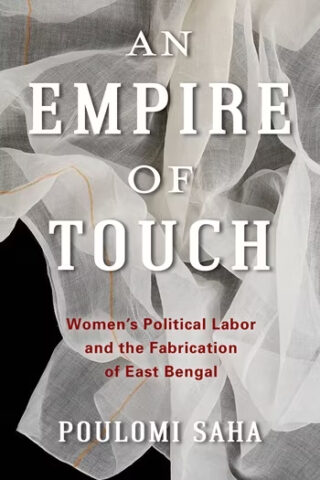
An Empire of Touch
By
7.20.23 |
Symposium Introduction
Poulomi Saha’s An Empire of Touch: Women’s Political Labor and the Fabrication of East Bengal makes many important interventions in South Asian studies and postcolonial studies writ large, first and foremost by foregrounding the egregiously overlooked and under-recorded political and manual labor of women in forming modern India, Bengal, and Bangladesh. Even more exceptional is Saha’s focus on the eastern half of Bengal. In its simple move from West to East, the text already poses an arch challenge to the way postcolonial studies has so often fashioned Bengal as a synecdoche of colonialism and its aftermath, a practice now perceived as a tiresome cliché. Into the twenty-first century, postcolonial studies in the main has grown resistant to modeling its political and discursive paradigms on the historical exigencies of pre- and post-Partition India. More narrowly, scholars within South Asian studies have raised concerns about the employment of Bengal as a metonym for all India, and in general, about the facile conflation of India as nation-state with South Asia as region. In other words, we are now necessarily compelled to acknowledge that Bengal does not stand in for India, that India does not stand in for South Asia, and that South Asia does not stand in for the entire postcolonial condition.
But by turning our glance eastward, Saha reminds us that the imagined “Bengal” of which postcolonial studies seems to have grown tired is not, in truth, a fully realized Bengal. The academic version of Bengal has thus far largely referred only to the western—and post-1947, Indian—half. An Empire of Touch begins with the provocation that its “reading of East Bengal revises the narrative of political modernity offered by postcolonial studies, which has historically focused on West Bengal as an ur-representation of British empire and anticolonialism” (Saha 17). Ostensibly, this should not be a radical move. After all, even in 1905 when the region was first partitioned by Lord George Nathaniel Curzon, over half of Bengalis resided in East Bengal. And today, the vast majority (by an order of magnitude) of subcontinental Bengalis inhabit the sovereign nation-state of Bangladesh, whose border with India is almost identical to that of the imperial Curzon-drawn line segregating East from West. An academic focus on East Bengal should be, if nothing else, a demographic given.
And yet, Saha’s centering of East Bengal is incredibly radical, as evidenced by the relative and astonishing paucity of scholarship on East Bengal in South Asian, postcolonial, and literary studies alike. Anglophone scholarship on Bangladeshi cultural production is incipient, similar scholarship on pre-Partition East Bengal is sparse, and in the case East Pakistan during the 1947–71 interregnum period, scholarship is nearly non-existent. Compared to work on the 1947 Partition of India and Pakistan, academic discourse on the 1971 violent uprising in the eastern wing of Pakistan that led to the formation of a sovereign Bangladesh is meager. An Empire of Touch does vanguard and deeply necessary work in its regional focus, in part by insisting on the importance of East Bengal/Bangladesh within the progressive, extractive histories of empire and global capitalism.
Saha’s work prompts us to dedicate more time, credence, and study to the eastern half of Bengal and complicate timeworn, threadbare references to microfinance, overpopulation, famine, George Harrison, “Save the Children,” and labor exploitation. It additionally suggests that East Bengal cannot and should not be conjured exclusively in the nostalgic (and definitively Indian, West Bengali) terms of a homeland lost. To the contrary: for contemporary Bangladeshis, East Bengal is the substrate of a nation founded on shared principles of linguistic, cultural, and religious affiliation. By simply insisting that East Bengal even exists outside its figuration as mere problem or memory, Saha’s intervention is radical. East Bengal is the Bengal that is decidedly not a postcolonial cliché, not a stand-in for the whole of South Asia, not a case study that has worn out its efficacy as a heuristic. An Empire of Touch steps through the looking glass and reflects back the Bengal that postcolonial discourse forgot, or more insidiously, the Bengal it ignored.
Radical, too, is the book’s methodological approach, which is manifold. Departing from the standard form of literary scholarship, Saha defines text and textile broadly, thinking through the haptic and somatic as much as, if not more than, the read and the seen. Comprehending empire through a history of touch is what guides each chapter: not the moment of contact itself but touch displaced or deferred, touch as fetish. Touch, for example, as a weaver’s trace on the warp and weft of fabric. Or touch as the stain of a jailed freedom-fighter’s fingerprint. Or touch as the singe and ash of the immolated. Or touch as the embroidery stitch of the artisan or dropped stitch of the garment worker. The question, at bottom, is how to comprehend the unrecorded role of women’s labor in the making of East Bengal, how to perform a version of subaltern historiography where there is no written archival grain against which to brush. Saha implicitly answers Gayatri Spivak’s now incantatory question of whether the subaltern can speak by countering that we cannot address that specific query without examining what she makes.
As such, the objects of Saha’s analysis include the written and spoken, but also the crafted. Some chapters do center on canonical work such as literary and political texts by Rabindranath Tagore and Mahatma Gandhi. But more often, the objects studied are as varied as the puzzling statuette of Vishnu gifted to Sigmund Freud by the Indian Psychoanalytic Society, the contrasting weaves of fine muslin and rough khadi fabrics as analogs of cosmopolitanism and nationalism, Pratilata Waddedar’s revolutionary pre-Partition pamphlets on Indian independence, and even Saha’s own thwarted attempts to excavate the haphazard Bangladeshi archive documenting the lives of birongonas, i.e., women who were raped during the 1971 war of liberation. Accounting for the labor of silenced, forgotten, or ignored women in the fabrication of the silenced, forgotten, and ignored region of East Bengal requires that we read in a new way—not with nor against the grain, as it were. Rather, Saha’s work encourages us to simply read the grain itself: that is, to analyze the material we study and the conditions which produced it as seriously as we analyze what it represents. An Empire of Touch seeks to reveal the voice through the touch of the woman laborer, rendering both at once legible and tangible.
I am delighted that in this symposium on Saha’s deft and innovative weaving together of history, art, literature, and theory in An Empire of Touch, Syndicate has granted me the opportunity to think alongside five formidable scholars from diverse disciplinary affiliations. To begin, Cristin McKnight Sethi stages a generative comparison between the East Bengali textiles of Saha’s focus to parallel fabrics from Punjab, a region also bifurcated in the 1947 Partition. Sethi’s piece similarly treats textile as text, focusing on the haptic to read marks on fabric as traces of the laborer. As such, it presents a thoughtful and thought-provoking extension of Saha’s work by searching for traces of “touches within touches” in figurative embroidery, e.g., scenes of churning butter and donning jewelry. Sethi goes on to consider the prohibition of touch through methods of conservation—that is, the opposite of reading through touch—thereby highlighting the limitations of exhibiting textiles in museum settings.
Next, An Empire of Touch prompts Durba Ghosh also to raise the question of the haptic in comparative terms, interpolating Saha’s notions of touch and texture in the analysis of conversant art forms. Rather than types or regions of textile production, Ghosh thinks about fabric in contrast to sculpture, as well as fabric rendered into sculpture. The piece analyzes the differing presentations of two busts of twentieth-century revolutionary Pratilata Waddedar, the subject of Saha’s first chapter: one located in Indian West Bengal and one in Bangladeshi East Bengal. In so doing, Ghosh implicitly raises important questions of the relation between artistic or artisanal form and the politics of revolution.
Parama Roy then offers a reflection on the western philosophical representation of the hand in relation to Saha’s notion of touch. Drawing on Heidegger’s notion that it is the hand itself which distinguishes humanity from nature, Roy attends not only to its touch, but also to its labor—the trace of fine handiwork. The piece goes on to track the motif of Dhaka muslin as a revered and rare product in the nineteenth-century English novel, identifying the representation of muslin as a marker of class as it made its way into the Victorian fashion. Roy stages a fascinating conversation between imperial nodal points, following Saha’s positioning of textile as text in East Bengal on to its sale and circulation in the British metropole. Informative about the life of Dhaka muslin as a coveted and fetishized commodity with a seeming life of its own, Roy’s piece suggests that touch goes both ways. In addition to tracing the touch of deft weaver in muslin’s fabrication, Roy asks us to consider the consequences of who the muslin itself touches at the other end of capitalist exchange.
Next, Neelofer Qadir considers the way Saha stitches together the stories of early twentieth-century freedom fighters such as Waddedar with the violated birongonas of 1971. Qadir inquires after this method of transhistorical suturing which brings into relief stories of the women positioned as the most precarious and most grievously harmed during moments of political upheaval. As such, the piece raises the question of whether historical and political repair can ever be a categorical possibility outside of logics of extraction and the purview of the state. Qadir connects the figures of anticolonial resistance centered in Saha’s work to artists and activists further afield, finding allegiance in the projects of performance artists Shailja Patel and Meera Sethi, art collective the Bad Fiji Gyals, and digital artist hiba ali.
Finally, Neilesh Bose approaches An Empire of Touch from a South Asian historian’s perspective, commenting on the outcomes of Saha’s unorthodox methodological turns. Bose submits that this crossing of disciplinary boundaries has the potential to compromise traditional notions of rigor and consistency and asks what is being left out in the service of Saha’s innovative and interdisciplinary study of East Bengal. In particular, Bose identifies the need for more engagement with the East Pakistani period of East Bengal between 1947–71. Eliding this period, Bose argues, has the effect of casting aside the pressing question of religion’s consequential force in shaping the geopolitics of Bengal in the nineteenth and twentieth centuries, and indeed, in exacting increasingly dire costs in the twenty-first.
Originally published in 2019, An Empire of Touch joins a burgeoning movement to rethink the ways Bengal has been positioned as the paradigmatic example of the postcolonial condition—that is, Bengal qua West Bengal, qua Indian Bengal. Though multiple conference panels on Bangladeshi and Muslim Bengali literature have convened at recent proceedings of the Modern Language Association and the American Comparative Literature Association, Saha’s text is among the first scholarly monographs, especially in the literary and visual arts, to shift its discursive focus onto East Bengal. As such, An Empire of Touch performs the task of redefining what Bengal can and should signify in South Asian and postcolonial literary studies. My hope is that this forum provides not only a space for generative exchange on Saha’s groundbreaking work, but that it issues an implicit prompt to continue much-needed work on East Bengal—a region that has for centuries functioned as one of the most important touchpoints in the networks of colonialism and global capitalism yet remains relatively untouched in postcolonial scholarly discourse.
8.3.23 |
Hand Made?
Reading An Empire of Touch
Poulomi Saha begins An Empire of Touch with an epigraph from Agha Shahid Ali’s “Reading Dorian Gray in Kashmir,” an early draft of “Dacca Gauzes,” one of his most famous poems:
“Dorian Gray wore those gauzes from Dacca
known as woven air, running water, evening
dew, that transparent cotton a dead art
now, dead for over a hundred years,
No one can imagine, my grandmother says,
what it was to wear, just to touch, that cloth.”
In The Picture of Dorian Gray, the protagonist becomes for a while a collector of rare, exquisite, and vanished artifacts, including “the most exquisite specimens that he could find of textile and embroidered work . . . the dainty Delhi muslins, finely wrought with gold-thread palmates and stitched over with iridescent beetles’ wings; [and] the Dacca gauzes, that from their transparency are known in the East as ‘woven air,’ and ‘running water,’ and ‘evening dew.’” Filled with melancholy at “the reflection of the ruin that Time brought on beautiful and wonderful things,” he engages in an ubi sunt-style lament about the lost life of legendary textiles.
Gray’s lament occurs in a late-Victorian imperial moment, in the last decade of the nineteenth century. Robert Stilling makes the perceptive observation that the mention of the Dacca gauzes is no mere notation, sympathetic or otherwise, of a sybarite’s desire for accumulation of the goods of distant lands. Wilde, he notes, was acutely aware in his capacity as an editor of Woman’s World of the aesthetic and ethical costs of British industrialisation, the resulting poverty of artisans across Europe and Asia, and the imperial trade policy that fostered these calamitous effects. He was a vigorous advocate in his essays of the repudiation of mere realism in Eastern decorative arts and, in one of his reviews, championed “Eastern design as a model for what might be accomplished artistically not by industrial machines but by hand.”
What did it mean, though, to make something by hand? In her magisteral summing up of the affect produced by the exquisite and evanescent hand-made products that were the Dacca gauzes, Saha uses a very particular vocabulary. The “artistry and magic of [the] manufacture” of muslin is inextricable from “the enigma of its becoming”; it is “mythical,” a cloth so “numinous” that writers speak of it as the product not of human hands but “the ‘work of fairies or insects, rather than of men’” (1—2). Endowed with “an aura of magic,” the muslin of Dacca “appears denuded of its manual origin. The hypernatural names of that muslin—bafthawa (woven air), abrawan (running water), shubanam (evening dew)—suggest that nature alone might produce objects so ethereal” (99). Admiration so lavish functions to identify the muslin as the work of invisible or minute beings—fairies or insects—belonging to the supernatural and animal realms. It bypasses the human altogether. Might one analogise this magical textile, and the occultation of human labour that goes into creating its legend, with the appearance of Acheiropoieta (“made without hands”)—Christian icons, such as the Shroud of Turin or the veil of Veronica, said to have come into existence miraculously, not created by human hands?
More prosaically, what kind of a hand—or hands, rather, since the phenomenology of weaving involves the fingers of both hands—might produce work of this nature? From Aristotle to Engels to Heidegger—that is to say, for thinkers who have pondered the articulation between specific bodily organs and intellectual and moral-spiritual capabilities—the hand has functioned as a mark of human distinction. For Heidegger the human hand distinguishes the human from the order of nature because it is an organ of signing, of pointing or indicating. The human hand is thus “monstrous” both in the sense of being an anomaly in the natural world and because of its function as monstrance, as indicative or demonstrative. For him the work or function of the hand is a species of Handwerk or handiwork, a way of expressing thought with one’s hands. The hand is thus inseparable from thought or signifying or indeed from speech. Though apes are also furnished with hands, these are not for Heidegger hands in any fundamental sense; as he famously insists, apes have prehensile “organs that can grasp” but paws, fangs, and claws should not be mistaken for hands as such.
Yet Heidegger’s masterful, singular, signing hand is not just normatively human; it is also normatively masculine. The work of the hands that are involved in weaving have historically had quite other, and distinctly gendered connotations, especially in Greek and Roman tradition, as Saha observes. While Ariadne’s thread may save her cherished Theseus from the Minotaur, and Philomela’s tapestry tell the story of her violation, Penelope’s weaving and unweaving over four years of a shroud for her father-in-law Laertes is an ambiguous sign of the somewhat dangerous wiliness of wives officiating in the household while heroes labour away from home. In narratives about Bengal, too, weaving was associated by Western observers with femininity, regardless of whether the weavers were women or men. Saha quotes John Forbes Watson on the gendered conditions of weaving; the cotton could only be woven, it was said, while the morning dew was on the grass, and only by a woman under thirty years of age (2). In his History of Silk, Cotton, Wool and Other Fibrous Substances (1845), Clinton G. Gilroy marvels at the incomparably fine fabrics produced under circumstances where so little human initiative or mediation of raw materials appear to have been exercised—“where the raw material has been so grossly neglected, where the machinery is so rude, and where there is so little division of labor.”
Once produced, what kind of a sensorial life do these muslins have? The paradox about textiles produced by the finely honed “hand of the Hindu” is their inaccessibility to the senses. There is a peculiar tact—something akin to extra-sensory perception—that is required to perceive or possess them, whether through ocular or tactile means. Writers retailed exorbitant tales of a fineness that defied easy detection; to be able to feel or grasp muslin required a sensitivity with which few were endowed. A commonly told story featured a Dacca weaver who was punished for leaving a sheet of Abrawan muslin on the grass, where it was consumed by a cow who had failed to distinguish it from the verdure upon which it fed.
Dacca muslins found admirers beyond the courts and officialdom of the subcontinent. The English and Dutch East India Companies first imported muslin to Europe in the early seventeenth century, though efforts were under way since the 1690s to ban Bengali cotton textiles from Britain in order to protect domestic wool and silk industries. Between 1721 and 1744, British legislators outlawed the importation of all Indian fabrics, including muslin. Once the ban was lifted, muslin became an increasingly popular material in Britain, France, and the North American colonies for women’s attire, regardless of age or class. In the 1780s and 1790s muslin’s light, flowing, and washable character, along with its amenability to dyeing, made it the preferred material for women’s gowns, helping usher in a novel style of women’s clothing. Muslin, plain, figured, spotted, sprigged, and tamboured or embroidered, finds favour among the female characters in Austen’s novels, and the first extended conversation of Catherine Morland and Henry Tilney in Northanger Abbey (1818) features Tilney’s surprising connoisseurship of muslins and his preference for those of Indian rather than British manufacture.
By the turn of the century British women as well as French ones had taken up dressing à la grecque in semi-transparent, high-waisted, slim-cut muslin gowns that often bared the arms and part of the bosom. “Muslin was ideally suited to reproducing the draped effects of antique statuary,” remarks a scholar of fashion. “Whether the increasing popularity of a light and restrained neo-classical style of dress was a result of muslin’s special properties, or whether muslin became popular because it lent itself so well to this style is a chicken-and-egg question.”
Muslin’s imperial incarnation in the fashions of European gentlewomen repeated some of the tropes of its gossamer character, though often in a distinctly satirical register. Where the story of the princesss Zebunissa serves as a testament to the textile’s ethereal splendour, satirists represented the wearing of gowns made of muslin, as opposed to those made of stouter fabrics, by European women as indistinguishable from nudity (Fig. 1). The caricaturist James Gillray, on the other hand, indicted not muslin’s sheerness but its all too solid materiality, liable to combustion in damp British interiors heated by fires. In one of his caricatures, a muslin-clad lady, seated in a room with a print of Mount Vesuvius in mid-eruption on the wall, reacts in alarm as a poker from the fire ignites her dress (Fig. 2).
The muslin that British ladies wore was increasingly of domestic manufacture, as cotton mills in Manchester, Lancashire, Norwich, Glasgow, and Paisley came rapidly to replicate Bengal muslins; though, as we know from Henry Tilney’s testimony, the Indian product was deemed superior, British-made goods had the advantage of cheapness and ready availability.
It should also be noted, of course, that the weavers of Bengal were not the sole victims of the international division of labour and the turn to machine-made rather than hand-spun textiles worldwide (including India). As had happened in India, handloom weaving and household production were replaced by power loom weaving factories in Britain. Britain’s position in the forefront of industrialisation offered its displaced workers, both male and female, better opportunities for wage earning than were available to Bengali weavers. But Dickens captures, in Hard Times (1854), something of the moral and bodily reduction of the British workers who laboured in the mills: “[There were] among the multitude of Coketown, generically called ‘the Hands,’—a race who would have found more favour with some people, if Providence had seen fit to make them only hands, or, like the lower creatures of the seashore, only hands and stomachs. . . . So many hundred Hands to this Mill; so many hundred horse Steam Power.”
The fabulous handmade muslins of Dacca and their economies of tactility have had a number of curious afterlives. In recounting them, Saha places special emphasis upon the manual technologies of repair for gendered trauma. Social workers engaged with birangonas (women raped during the war of liberation) used forms of tactile therapy—cooking, sewing, weaving, draping saris—for their restorative value. They also promoted the production of handmade objects—woven kanthas, embroidery, wood carvings—so that modern-day Philomelas could ensure “that some small sign of their experience endured, even and especially in the face of personal and national traumatic aphasia” (216). Similarly, kanthas stitched in response to the nearly 1200 deaths of mostly female garment-factory workers at Rana Plaza constitute a compelling and irreducibly corporeal testament of grief, created by hands that memorialise the most recent tragedy but also honour a longer history of embodied labour and embodied losses. We are indebted to Saha for a feat of critical imagination that can weave out of a chronicle of precarity and loss a text that restores to women’s hands a measure of self-articulation.
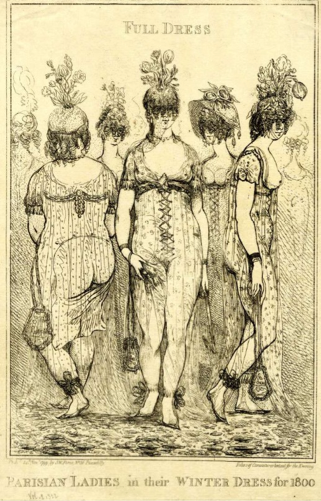
John Cawes, F. Samson, Parisian Ladies in their winter dress for 1800 (British Museum)
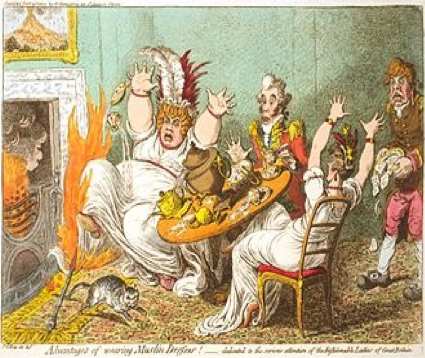
James Gillray, Advantages of wearing Muslin Dresses! (1802)
Robert Stilling, Beginning at the End: Decadence, Modernism, and Postcolonial Poetry (Cambridge: Harvard University Press, 2018), 43.↩
Stilling, 49.↩
Martin Heidegger, What is Called Thinking? trans. J.Glenn Gray (New York: Harper & Row, 1968), 16.↩
Clinton G. Gilroy, History of Silk, Cotton, Wool and Other Fibrous Substances (New York: Harper & Brothers, 1845), 345.↩
Gilroy, 345.↩
Gilroy, 345-46. ↩
Gilroy, 346. Weavers were largely Muslim, though Gilroy’s usage, and Mill’s, uses Hindu as a shorthand for all inhabitants of Hindustan.↩
James Maitland, An Inquiry into the Practical Merits of the System for the Government of India (Edinburgh: Archibald Constable, 1809), 129. ↩
Maitland, 128. Versions of this story crop up again and again. Valerie Steele notes that “Caesar complained that his wife appeared naked in public and she responded that she wore seven layers of the Indian cloth” (Encyclopedia of Clothing and Fashion, vol. 1 [Thomson Gale, 2005], 91). ↩
Susan Wolfson remarks shrewdly that “Mr. Tilney’s fluency in the fabric qualifies him as an honorary girlfriend, not cut from the cloth of the ultra-masculine hero” (Jane Austen, Northanger Abbey: An Annotated Edition, ed. Susan J. Wolfson (Cambridge: Belknap Press, 2014), 89, n. 14. ↩
Claire Hughes, “Talk About Muslin: Jane Austen’s Northanger Abbey,” Textile 4:2 (2006) 189.↩
Jonathan Eacott, Selling Empire: India in the Making of Britain and America, 1600-1830 (Williamsburg: The University of North Carolina Press, 2016), 281. ↩
Fanny Parkes, Wanderings of a Pilgrim in Search of the Picturesque, vol. 1 (London: Pelham Richardson, 1850), 386. Mary Martha Sherwood, The History of George Desmond (1821), 91. ↩
I am indebted to Bethany Qualls for introducing me to Gillray’s caricature of British women’s taste for muslin. ↩
Laura Miskin, “‘True Indian Muslin’ and the Politics of Consumption in Jane Austen’s Northanger Abbey,” Journal for Early Modern Cultural Studies 15. 2 (Spring 2015), 10. ↩
Charles Dickens, Hard Times (Norton Critical Edition), ed. Fred Kaplan (1854; New York: W.W. Norton, fourth edition, 2017). ↩
8.10.23 |
On Touch Trace and the Im/Possibilities of Repair
Poulomi Saha’s An Empire of Touch opens within wounds, juxtaposing the luminous lore of Dhakai muslin and the catastrophic collapse of the garment factory at Rana Plaza. First, the history of Dhakai muslin unfurls before us from the perspective of a multi-year project spearheaded by Dirk Picture Library, a visual arts agency in Dhaka. This once prominent and globally revered textile is no more, except when found ensconced by glass at museums, largely in the West. Legend, which Saha demystifies in early chapters, has it that British colonists amputated the weavers’ thumbs: “Dice a people, digit by digit” as Shailja Patel sings it in Migritude (5). Centuries later, imbricated in the grip of another empire, the United States, some twelve hundred workers—the vast majority of them young women—are buried alive at their workplace when an eight-story building falls in on them. Set between these moments that share Dhaka as a site, Saha conjures a tale of women’s labors and politics.
By attending to the materialities of cloth like Dhakai, khadi, taant and kanthas, An Empire of Touch catalyzes historical moments obscured by the cataclysm of 1947 such as the 1905 partition of Bengal and the anticolonial protests of the 1930s to activate the “apparitional form” of East Bengal that “ruptures postcolonial chronospace” and produces a “powerfully felt transhistorical transnationalism” (11, 13). Divided into three parts—“Reading the Body Politic,” “the Fetish of Nationalism,” and “International Basket Case”—the book fashions reading practices of touch and trace, “of materiality and intimacy” (4). Saha examines a wide range of source material from canonical texts such as Rabindranath Tagore’s 1916 novel The Home and the World and Mohandas K. Gandhi’s Collected Works and colonial and state archives to personal interviews with social workers, private collections of a journalist, rumors, and unpublished personal essays by contemporary garment factory workers.
Among the more fascinating aspects of this project is the breadth of sources and the methodological practices they invite. In particular, I am intrigued by Saha’s positioning of the anticolonial revolutionary Pritilata Waddedar as “both a historical figure and theorist of her own historicity” (31). Thus, with little reluctance, I leave to the side “the historical darlings of the postcolonial and Western canon” (8)—Tagore, Gandhi, Freud—whose bodies of work have received prolific attention elsewhere and in the “Fetish of Nationalism” chapters of An Empire of Touch. Rather, I am much more curious to follow how, in Saha’s reading, Waddedar writes herself out of a colonial archive that insistently attempts to discipline her and diffuse the power of her political action even if—and perhaps especially since—this archive becomes the means through which scholars today can access her pamphlets, “Long Live Revolution” and “An Appeal to Women”. As I read, I wondered if the birangonas and garment workers examined in the later chapters are, similar to Waddedar, historical figures and theorists of their own historicities; or, if Waddedar’s figuration as such critically relies on self-immolation, a practice of political protest not (yet) enacted by birangonas or garment workers. How might Waddedar, memorialized in a bust from a torso up, sari draped across her shoulder, dialogue with the garment workers killed in the Rana Plaza collapse whose families stitched kanthas in their memory and exhibited them amongst “[w]ild marsh grasses and water hyacinth … [that took] over the building footprint” (247)? Saha notes that Waddedar’s state-sanctioned memorialization takes the form of a “public gendered disciplining” (69), an action that not only sits in substantive tension with the clothing she used as her disguise to enact her anticolonial rebellions, a raid on the Pahartali Railway Institute and her death by suicide, but also in how it rewrites a history of a collective political movement into a memorialization of a singular heroine. Because Kalpana Dutt, Waddedar’s sister in anticolonial revolutionary praxis, lived to stand trial, “[h]er archival trace is rich” (69) in contrast to Waddedar’s whose appearance within the colonial archive is elusive and fragmented. In this sense, the archival trace, so to speak, of the garment workers disposed through the necropolitical logic of global capitalism is most felt through the aliveness of their kin and their kin’s private grief made public through the exhibition that both wove itself in the fabric and style that Bengali women have made for generations (kanthas) and in its reaching back in time and across oceans to another capitalist disaster, the 1911 Triangle Shirtwaist Factory fire.
To beckon Waddedar more insistently into the contemporary is to ask about the shape of feminist solidarities between Chittagong and Dhaka; it is to ask how 1932 and 2015 might be in conversation. How do insurgent imaginations and practices shape an ‘against’ or an ‘outside’ to the imperial structures that condition(ed) and constrain(ed) the lives of all these women? Can those who have been figured as birangona by the postcolonial nation-state of Bangladesh and those who live and labor as garment workers in circuits of global capitalism, on whom Bangladesh’s position as middle-income country and developmental miracle sits, speak with Waddedar and Dutt?
In “Archives Asylum” Saha eschews the more commonly utilized source material of the oral history to investigate the state-sanctioned term ‘birangona’ and what escapes its folds.
She argues that this term “is a socially empty category” with “no interior subject position that belongs to the birangona” (175, emphasis original). According to Saha, the use of ethnographic methods such as interviews and oral histories sit in an uncomfortable relation of reifying positivism as the singular “corrective to state and global amnesia” (172). In her tracing of the term, “birangona” retains a hold in the publication imagination yet is almost never reproduced in official narrative. I am reminded of Durba Mitra’s study of knowledge production project of the prostitute in colonial India which shows that the prostitute “was trafficked as a concept in the service of the development of colonial social science, claims to scientific expertise, and new social theories on the progress of Indian society” (5). Indeed, it seems that the state’s construction of birangonas as a population category is mediated very much so by ideas of managing sexual deviance and criminality for as Saha reveals the word is haunted by its “near homonym barangona বারাঙ্গনা, which means prostitute” (180, emphasis original). These efforts toward rehabilitation are a biopolitical project par excellence from eugenic practices
The saris that social worker and Girl Guide Maleka Khan carried with her when recovering women from the encampments where they had been held indexes the vexed relationship between rehabilitation and repair. Saha tells us that taant is an “intimate technology” that it is “instantly geographically recognizable [because it is] woven only in Bengal.” It is an “egalitarian fabric … a life-giving textile for the poor” (195). She suggests that Khan’s saris made kinship possible by offering a “bridge of care … that bound together [their bodies] by the local textile of Bengal” (194-5). But, also that this “tacticility … mark[ed] the rehabilitation program” (195). In the space between the binding and the marking, I wonder how else this kinship might have been fashioned and what those possibilities would be like. Could this encounter have taken place outside of the purview of the state? What motivated Khan to carry the saris, a choice that opened a different site of mediation between her and the women she found? How else can we tell this story of the initial encounter between the violated women and Khan? Was the touch of an unfamiliar person welcome, even as it carried traces of familiarity? I cannot help but stay with the fact that the narrative remains partial and what we receive is from the perspective of Khan alone, documented as it is through an interview between Khan and Saha. More than a desire for a total whole that includes the voices or perspectives of the women Khan found, I am curious about the site of their encounter and what is rendered impossible, even in that initial touch. I suspect the story of repair—its possibility and promise—must be told foremost by the demands of those most grievously harmed and perhaps also those who hold repair not as a fixed position to be reached, but an ongoing mode of relation, especially in view of how postcolonial states, Bangladesh among them, remain beholden to imperial centers like London and New York alongside their transnational avatars such as the International Monetary Fund and the World Bank.
In reaching toward accomplices in feminist anticolonial and anti-imperial revolution, the work of several visual artists and cultural workers comes to mind. Canadian visual artist Meera Sethi’s participatory art project Unskilled: New Clothing Care Symbols, “an exploration of the life cycle of clothing labour from seed to closet,” (Seethi “Unskilled”) speaks most directly to how those of us situated in the Global North, especially, might refashion our relation to the “material intimacies” (Saha 22) of the garment and the laborers who produce it. Another of Seethi’s projects, #Unstitched, which focuses on remediating the sari into as a way to build community across the diaspora recalls Patel’s Migritude, both performance and book (see Qadir 2018; Reddy 2016). Digital artist hiba ali’s “rough as silk” traces their family histories, particularly its imbrication with histories of unfree movement and labor, that bring eastern Africa into contact with South Asia and Arabia through the commodity forms of silk and slavery. Ali tells us, “our lives are indebted to silk worms” (“we the silk worms (rough as silk)”) “we live in the silk and sea of the Indian Ocean … our stories span the ocean. The water always remembers like silk” (“in the cyclone (rough as silk)”). Coolie Cut Cane: The Sugar Empire of the South Pacific, a collaborative essay by Quishile Charan and Esha Pillay (Bad Fiji Gyals Collective) to accompany the online exhibition of Charan’s online exhibiton of Coolie Cut Cane, is a profound engagement with girmit histories on sugarcane plantations across the South Pacific, that weaves girmitiya histories into the broader project of genocidal settler colonialism and blackbirding. Charan’s handmade textile works, such as “to grieve among the sugarcane fields” (2018) and “we do not have enough to satisfy our bellies” (2019) are powerful memorials not only to the visual histories of Girmitya women’s political resistance but in keeping alive heritage practices of dying, embroidery, and weaving (Charan and Pillay, “Fiji Baat” 15-17) as embodied epistemes that remember, honor, and shape girmitya histories, presents, and futures.
An Empire of Touch exercises our thinking on how fabrics, such as Dhakani, khadi, taant, and kantha, craft an intimacy of touch but also produce an opacity; figures like Waddedar, birangonas, garment workers exist in that mediation between knowability and unknowability, as prized markers of the state’s desire for regulation and capture yet ardent resistors of its disciplining apparatus. In its most generative moments, An Empire of Touch insists that we investigate our relationship to archives. In particular, it has stressed to me how much is contingent especially in the face of normative claims to totality. For me, lingering questions on the tensions of archive, contingency, and scale undergirding the text remain: How might we interrupt the temporalities of colonialism, imperialism, and capitalism in a sustaining duration, one that makes possible a splintering away from the violences that have shaped the conditions of these women’s lives and labor? How else can we suture together these women’s political labors without resorting to capitalist and neoliberal logics of accumulation that threaten to undo the revolutionary threads of relation?
Bibliography
ali, hiba. “rough as silk (2017-2021).” Accessed May 18, 2022. https://hibaali.info/projects/as-rough-as-silk
“Bengal Muslin.” Accessed September 12, 2021. http://bengalmuslin.com/
Charan, Quishile and Esha Pillay. “Coolie Cut Cane: The Sugar Empire of the South Pacific” Bad Fiji Gyals. Last modified April 2021. https://coolie-cut-cane.badfijigyals.com/
Charan, Quishile and Esha Pillay (aka Bad Fiji Gyals). “Fiji Baat: Quishile and Esha at the 13th Gwangju Biennale.” Last modified February 2021. https://badfijigyals.com/fiji-baat/episodes/quishile-and-esha-at-the-13th-gwangju-biennale-south-korea
Islam, Saiful. “Muslin. Our Story.” Garland. April 20, 2016. https://garlandmag.com/
threads/muslin-story-saiful-islam/
Mitra, Durba. Indian Sex Life: Sexuality and the Colonial Origins of Modern Social Thought. Princeton: Princeton University Press, 2020.
Nadkarni, Asha. Eugenic Feminism: Reproductive Nationalism in the United States and India. Minneapolis: University of Minnesota Press, 2014.
Patel, Shailja. Migritude. New York: Kaya Press, 2010.
Qadir, Neelofer. “Migritude’s Decolonial Lessons.” Eastern African Literary and Cultural Studies 3, no 3-4 (2018): 221-243. https://doi.org/10.1080/23277408.2018.1462934
Reddy, Vanita. Fashioning Diaspora: Beauty, Femininity, and South Asian American Culture. Philadelphia: Temple University Press, 2016.
Seethi, Meera. “Unskilled.” Accessed May 18, 2022. https://meerasethi.com/unskilled
Seethi, Meera. “One Spirited Evening in August.” September 2, 2015. https://meerasethi.com/
news/2017/2/1/launching-unstitched-the-sari-project
I am especially interested in how a temporally multidirectional dialogue that figures garment workers and birangonas as theorists of their own historicity, as Saha asserts Waddedar to be, lead us to an even more critically expansive engagement with Waddedar (and the IRA’s) legacy. How might the peculiarities of caste and class (differences) reshape the intellectual and political history of anticolonial uprisings in British colonial India?↩
In her analysis of Dutt’s file, which, by comparison to Waddedar’s, is expansive, Saha attends to the impossibility of deciphering whose hand produced certain texts given the similarities in handwriting. Rather than an authenticating modality, the repetition of the text found on Waddedar’s body and the materials in Dutt’s file “refus[e] the fantasy of individuation” desired both by the colonial state in its attempts to correlate Waddedar’s hand with her body and haunts the manner in which the postcolonial state renders Waddedar a hero, for instance, in the form of the bronze bust.↩
In particular, I am thinking here with Asha Nadkarni’s theorization of eugenic feminism, a concept she elaborates through a study of India and the United States that examines how hegemonic feminism operates by linking issues of right reproduction to national development.↩
8.17.23 |
Amar Sonar Bangla
A Light Touch
Saha’s Empire of Touch brings to post-colonial cultural criticism the site of East Bengal, and at times, the nation-space and the contemporary context of Bangladesh into view in ways that few literary critics ever have done. Saha weaves into one narrative an array of primary sources, from novels and short stories and films and photographs to the lives and perspectives of historical actors (in conversation with fictional character in literature) as well as meditations on history itself. Difficult to categorize in terms of genre, the book appears to have been written for English-language cultural critics versed in postcolonial studies. It does not appear to have been intended for scholars of the history, culture, and politics of East Bengal. Certainly, all academic books carry with them a complicated politics of audience, with numerous interventions shaping its final form, all unknown to readers. But as a work of interdisciplinary scholarship, historians, literary critics, and scholars of visual and material culture are all potential readers. Saha touches lightly on all of these disciplines, fixated on women in and of East Bengal from the early twentieth century to the present. However, as I detail below, these touches appear without any serious consideration of the role of religion, communalism, and the contested field of secularism in the making of East Bengal. As I claim formal expertise in history but not in the various other disciplines addressed by the sorts of materials assembled in this book, I confine my reading to that of a historian. Undoubtedly, nuggets of insight emerge from a variety of gazes; history certainly isn’t the only perspective one may take to read a book about East Bengal’s past and present. To be fair to the author, nowhere does she claim to be offering a history in any coherent sense. The author rather offers a series of sketches about moments, objects, individuals, and fictional characters. In chapters about topics as disparate as Pritalata Wadedar, a late colonial revolutionary who committed suicide (or sati, in Saha’s rendering), a statue of Vishnu gifted to Freud, readings of Rabindranath Tagore’s fiction and Satyajit Ray’s films, archives in Bangladesh, and the labor of garment workers in Bangladesh, the author aims to insert East Bengal into conversations about postcolonial criticism, an entirely laudable and worthy goal. To return to questions of audience, how to assess this goal and whether the author achieves it depends on which sort of readership is presumed under the mantle of “postcolonial.” Many historians have explored East Bengali historical actors, social movements, and institutions within studies of colonial and post-colonial time periods. Figures as intellectually diverse as historian Ahmed Kamal, activist Hameeda Hossain, public intellectual Meghna Guhathakurta, and the late litterateur Anisuzzaman (1937–2020), to more recent historians, often directly challenge older presumptions in subalternist historiography.
Whose “East” in whose Bengal?
In her emphasis on the “East” in her conception of East Bengal, Saha raises questions about which Bengal is actually in her line of vision. In her description of the East Bengal being studied, from the 1905 partition to the present, she skips over any mention of East Pakistan, the wing of Pakistan alive from 1947 to 1971 in what is now Bangladesh (6). East Pakistan is again skipped over when in the chapter on “Oceanic Feelings,” in a discussion of the novel and subsequent film adaptation of Tagore’s Home and the World, is seen as a “story about East Bengal in particular, it draws to the fore what gets lost in the move to the nation-state but does not fall away” (167). Though not the only facet of twentieth century East Bengal meriting attention, the existence of East Pakistan surely was one of those facets of the move to the nation-state in East Bengal? Does it not merit any recognition?
In her chapter “Archive Asylum,” as is often mentioned in a Bangladeshi nationalist style, “the new life of East Bengal” is seen as beginning after 1971. The time period of 1947 to 1971 is again lost, one supposes, forever. Her three conceptual registers of contingency, cathexis, and desh (11-12) suggest a regional-cultural romanticism, a conjuring of a Bengal devoid of internal differentiation, violence, and contestation, oddly visualized in the void of specificity. It is “both and neither the Indian-hued Bengal of postcolonial historiography and literary studies nor the Bangladeshi laboratory of postwar international development” (11). This book’s Bengal—ironically like much postcolonial literary criticism—erases from view any consideration of how and why Pakistan emerged in the East and how Bengali speaking people wrote about it. Additionally, the role of religion is mysteriously absent in Saha’s framing of this topic. In naming East Bengal as being consigned to the “waiting room of late capital,” Saha mentions theorists known to postcolonial studies, but not any scholars based in Bangladesh, or who specialize in East Bengali studies, or who write and engage in academic discourse in Bangla, are cited in this particular instance.
Archives and the question of history
This leads to a broader reflection about the meaning of history as a discipline. As she mentions in her chapter titled “Archive Asylum,” she refuses a historiography of mastery, citing Spivak and Derrida. Though appreciative of these references I wonder if a reading of history about East Bengal written in the current generation would confirm the notion that historians strive for “mastery.” It is true that East Bengal is a strangely silent referent in much discourse produced in the twentieth and twenty-first century
To return to possibly the arguably most important omission in the book, the role of religion, secularism, and communitarian sentiment deserves serious consideration for any study of East Bengal. The role of religion within nationalist and late imperial activism, the violence of partition that linked to religious markers of social difference, and the nature of religious minorities in India and Bangladesh after 1947 and 1971 is a depressingly important, and arguably one of the most central, facets of the history of twentieth century East Bengal. The creation of Bangladesh is incomprehensible without some understanding of these social and cultural historical changes in the twentieth century. At times, the author engages such issues, through a generative discussion of a film about Gurudashi Mondal in a fascinating analysis of the insane asylum at Pabna, and the subsequent depiction of her in a manner hard to categorize by existing frameworks. This valuable snippet of such lives triggers the need for a greater probing of the larger transformations in East Bengali and from 1971 onward, Bangladeshi society. These transformations revolve around changes in majoritarian and minoritarian politics, and in recent times, persecutions of various minoritized groupings in the name of the nation. Saha’s analysis of Mondal is invaluable to beginning such a project. Future scholars of East Bengal and Bangladesh will depend on these pioneering insights for a nuanced understanding of the gaps and limits of history that inhere in the sustenance of the Bangladeshi national project. Anyone addressing the topic of Bangladesh’s pre-history insofar as it relates to the present (as Saha does) must face these transformations directly, without hesitation. Otherwise, any ethical gestures drawn about the past will end up turning into fabrications of the lightest touch.
See Hameeda Hossain, The Company Weavers of Bengal: The East India Company and the Organization of Textile Production in Bengal 1750-1813 (Delhi: Oxford University Press, 1990), Ahmed Kamal, State Against The Nation: The Decline of the Muslim League in Pre-independence Bangladesh, 1947-1954 (Dhaka: University Press Limited, 2009), and Meghna Guhathakurta, “Family Histories of the Bengal Partition,” India International Centre Quarterly 25, no. 1 (1998): 126-43. Of the many works by the late Anisuzzaman relevant to studies of East Bengal, his Anisuzzaman, Muslim Manas o Bangla Sahitya, 1757 – 1918 (Kolkata: Pustak Bipani, 1964) is an invaluable resource. Recent work centering East Bengali historical actors include Andrew Sartori, “Abul Mansur Ahmad and the Cultural Politics of Bengali Pakistanism” in From the Colonial to the Postcolonial: India and Pakistan in Transition, edited by Dipesh Chakrabarty, Rochona Majumdar, and Andrew Sartori (Delhi: Oxford University Press, 2005), 119 – 136, Iftekhar Iqbal, The Bengal Delta: Ecology, State and Social Change, 1840–1943 (Basingstoke: Palgrave Macmillan, 2010), Neilesh Bose, Recasting the Region: Language, Culture, and Islam in Colonial Bengal (Delhi: Oxford University Press, 2014), and Tariq O. Ali, A Local History of Global Capital: Jute and Peasant Life in the Bengal Delta (Princeton: Princeton University Press, 2018).↩
The passage appears on p. 15, with the reference being Walter Benjamin, “Theses on the Philosophy of History,” Illuminations: Essays and Reflections (New York: Random House, 1968).↩
A special section of South Asia: Journal of South Asian Studies 41, no. 4 (2018): 827 – 923, titled “Oral Histories of Decolonisation: Bengali Intellectuals, Memory, and the Archive” analyzes the significance, insights, and limits of the project, https://www.tandfonline.com/doi/full/10.1080/00856401.2018.1514479. It also includes excerpts of interviews with a variety of individuals, such as Anwar and Afia Dil, Pranab Bardhan, Anisuzzaman, Hameeda Hossain, Gayatri Chakraborty Spivak, and Partha Chatterjee.↩
Saha does mention this point in her discussion of attacks on Hindu women, p. 198.↩
See Andrew Sartori, “Abul Mansur Ahmad and the Cultural Politics of Bengali Pakistanism,” Neilesh Bose, “Purba Pakistan Zindabad: Bengali Visions of Pakistan, 1940 – 1947,” Modern Asian Studies 48, no. 1 (2013): 1 – 36, and Ahmed Kamal, State against the Nation.↩
See Neilesh Bose, ““Inheritance and the Idea of the East in Banglaphone Thought” for South Asia: Journal of South Asian Studies 41, 4 (December): 863–75.↩
See Pika Ghosh, Making Kantha, Making Home: Women at Work in Colonial Bengal (Seattle, WA: University of Washington Press, 2020).↩
8.24.23 |
Close Looking in Visual and Material Archives of Touch
There are many compelling and provocative themes that emerge through Poulomi Saha’s An Empire of Touch which help us rethink scholarly engagement with archives and how we define and value different kinds of labor. Saha states in the introduction that this book “takes on a basic methodological dilemma of postcolonial studies: despite the centrality of women’s labor to anticolonial protest and postcolonial state-building, historiography has struggled with what appears to be an absence in the archive, born of the ostensible division between a public masculine world of politics and a private feminine world of culture, domestic life, and kinship” (6). This perceived lacuna of “the archive” is a dilemma only if the archives in question are text-based. Instead, if we look to the vast archives of visual and material culture that exist inpublic and private collections (e.g. museums), both inside and outside South Asia, the subjectivity of women and evidence of their somatic labor abounds. Saha rightly refocuses our attention on the ways that the “world of culture, domestic life, and kinship” can be understood as significant practices of anticolonial protest and postcolonial state-building (Saha argues that the problem is in fact our limited “conception of the political”) (20). Interpreting visual and material objects in various kinds of archives is a central strategy in an art historian’s toolbox, which sometimes requires that we decenter texts and remember that objects themselves are some of the best primary sources we have.
In the short essay that follows I would like to pick up on another central theme of Saha’s book—that of the somatic traces or touch of women’s textile labor—and to use objects themselves, rather than texts, to read those traces or remnants of touch. Saha’s study intentionally does not focus on the commodity objects of women’s labor and instead aims to recover the laboring female bodies themselves. However, I believe that it is worth looking closely at commodity objects as they may allow us to recover the somatic trace and subjectivity of those laboring bodies. In the paragraphs below, I attempt to do this by offering a comparison from another area of South Asia that was divided during the partitions of the twentieth century, that of Punjab, and specifically by looking closely at a group of embroidered textiles from that region.
Structural Touches
I would like to begin with a photograph that shows a detail from a large embroidered odhni (headcovering or shawl) made in pre-Partition Punjab sometime in the first half of the twentieth century (Figure 1). This photograph allows us to look closely at the structure of the large odhni and specifically to see the undulation of the handspun cotton threads which were woven to create the base fabric (khadi) upon which an embroiderer stitched patterns using golden yellow and creamy white-colored silk floss. There are several layers of touch that have accumulated in the structure of this textile, which are made visible in the photograph. The threads that constitute the warp and weft of the base cloth have been shaped through the touch of women’s hands, through the spinning of cotton fluff or fibers into thread, likely on a charkha (wheel)—a tool that Saha explores throughout the book’s second chapter, “The Fetish Touch,” within the context of Gandhi’s articulation of swaraj. The variation of these threads—thicker in some areas, narrower in others—are the result of a woman’s fingers pressing onto the cotton fibers through the process of spinning. The direction of the threads’ twist (“Z” spun) follows the natural inclination of cotton fibers, particularly when they are spun on a charkha. These threads also evince earlier touches: planting cotton seeds, harvesting cotton bolls, cleaning and carding cotton fluff to prepare the fibers for spinning, dyeing the spun threads—likely with madder (rubia tinctorium)—to obtain the deep rusty red color that appears now on the odhni, and the weaving of those threads into plain weave cotton cloth using a horizontal treadle pit loom. These are not only the touches of laboring female bodies, but also the residual touches of laboring men, as both men and women were involved in aspects of South Asia’s extensive and long-standing cotton textile industry.
Traces of Form, Pattern, and Time
This photograph reveals later touches too, most apparently the traces of the women whose hands embroidered elaborate geometric patterns onto the khadi base cloth using shiny silk floss (untwisted threads, referred to as pat). With this particular form of embroidery, known in Punjab as phulkari or jisti, the embroiderer used an elongated running stitch (sometimes referred to as a single-sided satin stitch or a darning stitch, rafugari) to produce long floats of silk floss that covered several warp and weft threads in a single stitch. This method is a “counted stitch” embroidery technique which requires the maker to count the number of warp and weft threads on the base cloth to determine where to place the next stitch. In this photographic detail, we see stitches that are between seven and ten weft and warp threads long, repeated at regular intervals, and following closely the warp and weft grid, to create even, rhythmic stitches that are reminiscent of extra-weft and -warp weaving (colloquially, “brocade”) made on a loom. In this way, the female body replaces the machine (a loom) typically operated by men. The somatic traces of this embroidery is different from the pressure of a woman’s fingers against the cotton fiber during the process of spinning, and instead evinces the touch of fingers to needle, needle to warp and weft threads, and hands to pull the needle (loaded with silk pat) through the khadi base cloth. Throughout this process the embroiderer’s hands are feeling the cloth, holding it, moving it across her lap, pressing the fibers—both cotton and silk—as she works.
A horizontal line appears bisecting this photograph and provides additional somatic traces that remain on the odhni. What we see is a seam in the fabric which shows us that the large odhni (Figure 2) was in fact created by stitching together four separate, narrower panels of embroidered khadi. Notably, the detailed photograph reveals the different moments when embroidery occurred and as such marks time in the life of the women who produced this textile. The light-yellow and cream-colored pattern that we see on the left side of the photograph (Figure 1) is a detail from the large composition of vegetal motifs that dominate the central body of the textile (Figure 3) and was created before the khadi panels were stitched together. We can see where the embroiderer(s) attempted to match the serrated band that separates the end border composition from the central body composition, and the small gap and unevenness between these two separate khadi panels (Figure 1). The deeper yellow pattern that appears in the end borders of the cloth, and dominates the right side of the photograph (Figure 1), was created at a later time. Notice that parts of the deep yellow pat embroidery stitches overlap the khadi seam, indicating that this part of the end border of the odhni’s composition was created after the embroiderer(s) created the central vegetal patterns and stitched together the khadi panels. Another detailed photograph of the odhni showing a larger portion of the end border composition provides additional evidence of this process (Figure 4). Details like this hint at the circumstances of female labor behind the making of the odhni: either multiple women were engaged in making this textile at different moments in time, each one tasked with embroidering one of the four khadi panels, which were later sewn together and finished by another woman; or a single woman was responsible for completing all of the embroidering but she worked in stages, from one narrow khadi panel to another, and added the yellow border pattern after she stitched all panels together. Either way, the odhni was created over time and pieced together: the layers of embroidery touches accumulating—over days, perhaps months—with partially-complete khadi panels inhabiting the living spaces of laboring women.
We can also read the passage of time and additional somatic traces by looking at the variations in hue that appear in the silk pat used to create the odhni. The detailed photograph of the vegetal motifs in the central body of the textile (Figure 3) show that the embroiderer(s) used multiple shades of cream-colored silk pat on this cloth. We can also see different shades of pat employed on different khadi panels (this photograph shows an artfully created seam connecting two panels, running vertically in the photograph) as well as different shades of pat being used on a single panel. These slight variations may indicate that the embroiderer(s) acquired pat at different moments in time, from different vendors, or from different dye lots. This practice reminds us that the silk pat itself traveled, accumulating touches, before it reached the Punjabi embroiderer(s) who made the odhni. Likewise, these variations in pat hue record the passage of time—the lives lived, the chores completed, the filial and communal relationships solidified or broken, the social occasions celebrated, the political or economic shifts experienced—that occurred in between and during the moments when women were embroidering odhnis. These variations in pat hue are like timestamps, marking duration and the multitude of touches that directly and indirectly participated in creating this object.
Touches of Desire
Somatic traces also appear in places of material disintegration: the broken fibers or faded dyes that evince moments when a woman wore the odhni around her body, sat on it or leaned against a wall, washed the cloth, hung it in the sunlight to dry, or folded it to store in an almirah. Other odhnis like this one similarly show places of damage and repair (what Saha might call “the accumulation of contact and intimacy” (150): stains or tears on the khadi and small patches created to repair sections of lost stitches—all material records of women who engaged in other kinds of labor (domestic labor, agricultural labor) while making, wearing, and touching an embroidered odhni. These somatic traces that appear on textiles evince the lives of women: we see material evidence of their presence, their actions, the restrictions placed on their bodies as well as their subjectivity and desires.
In Chapter 3, “Oceanic Feelings,” Saha discusses how Tagore’s novel The Home and The World illustrates the desires of women and disrupts conventional perceptions of the subjects of nationalism. Indeed, the theme of women’s desires is felt throughout the book and provides another way to consider the somatic traces on a textile like the Punjabi phulkaris that have been my focus here. I would like to now look at a couple different embroidered odhnis—also from Punjab, also made sometime during the first half of the twentieth century—which include figurative motifs that not only reveal somatic traces, but also speak to the desires and subjectivity of female embroiderers. Amongst the diverse group of embroidered textiles referred to as phulkaris, there exist a category of cloths known as sainchis, which are notable for their whimsical depictions of human and animal motifs (Figure 5).
Embroidery as Political
In focusing on women’s subjectivity and somatic labor throughout the book, Saha provides a roadmap for interpreting the political through seemingly mundane domestic tasks like embroidering an odhni. The terms “conjugal labor” and “conjugal commodity” which Saha uses in reference to the making of Dhakai muslin is particularly instructive (2). While phulkari odhnis enjoyed a different history of global circulation than that of muslin and resisted categorization as commercial commodities, many of these textiles similarly emerged through conjugal labor. Phulkaris were often produced by women of various ages for use by a bride (and sometimes a groom) to wear during ceremonies connected with weddings and as part of the material wealth that women brought to a marriage in the form of dowries and trousseaux. These textiles, then, were used as part of a marriage contract, establishing connections between families and supporting the procreative labor of a bride and groom, ultimately producing new citizens of the empire and later the new nations (India and Pakistan).
Anti-Touches
In an ontological about-face, the places where we most often encounter these embroidered textiles, in public and private collections around the world, militate against the very touches that brought these textiles into being. While a museum’s condition report or object catalogue might note the somatic traces of a textile—the materials and techniques used, thread counts, weave structure, places of distress and damage, or composition of motifs—most museum acquisition processes attempt to halt the residue of historical touches and restrict future touches for the sake of preservation. When a textile enters into a museum its first stop—before going into collection storage or being displayed in a gallery—is the freezer, where it remains for a few weeks to kill bacteria and pests and to prevent future shedding and disintegration of fibers. Most museums require visitors to their collection storage facilities to wash their hands and wear gloves when handling textiles in order to prevent dirt, oils, and other unwanted residue of human touch from leaving their trace on an object. Touches on fibers (human or insect) can slowly lead to the dissolution or degradation of materials (a kind of constant, invisible touch), and halting this process is often a museum’s priority.
The living traces of embodied lives and somatic labor that appear on textiles undergo a transformation in a museum, like the Vishnu statuette on Freud’s desk that Saha discusses: they become things that are quite literally frozen in time. We often cannot get close enough to an object when it is displayed in a museum, to see, like the phulkaris, described above, the touches that evince the lives and labors of its human makers; textiles on display are too often hung on gallery walls and framed like paintings, rather than draped on anthropomorphic forms or moving through space as they once were in earlier lives.
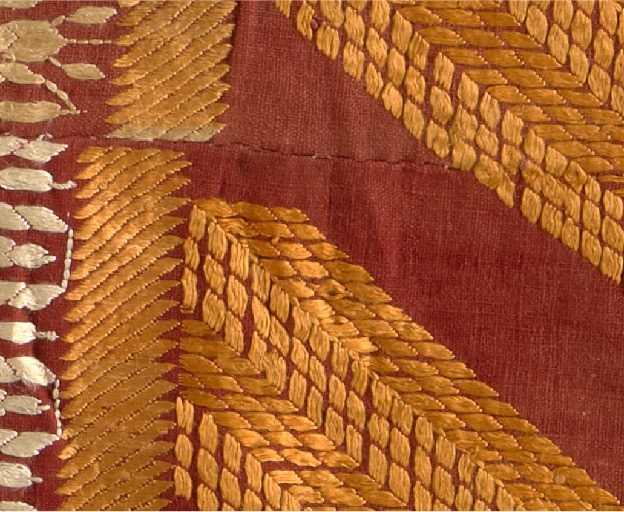
Figure 1. Detail of phulkari odhni, pre-Partition Punjab, India. 20th century. 226.70 L x 130.18 W cm. Cotton and silk. George Washington University and The Textile Museum, 1985.57.47.
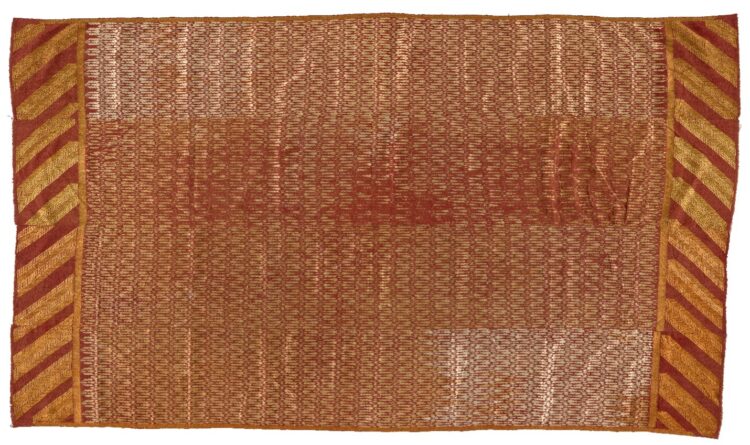
Figure 2. Overall view of phulkari odhni, pre-Partition Punjab, India. 20th century. 226.70 L x 130.18 W cm. Cotton and silk. George Washington University and The Textile Museum, 1985.57.47.
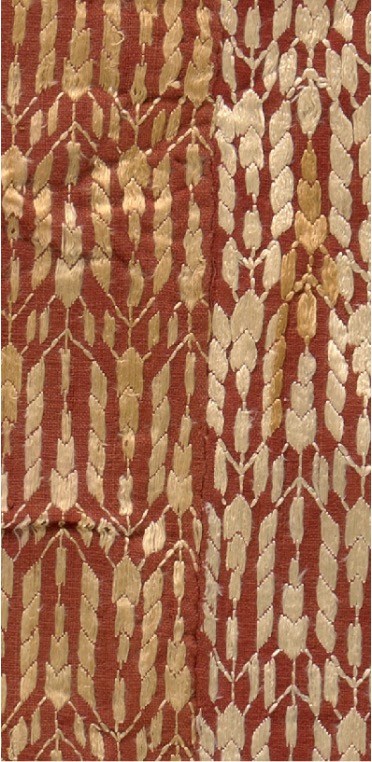
Figure 3. Detail of phulkari odhni showing vegetal pattern in central body of cloth, pre-Partition Punjab, India. 20th century. 226.70 L x 130.18 W cm. Cotton and silk. George Washington University and The Textile Museum, 1985.57.47.
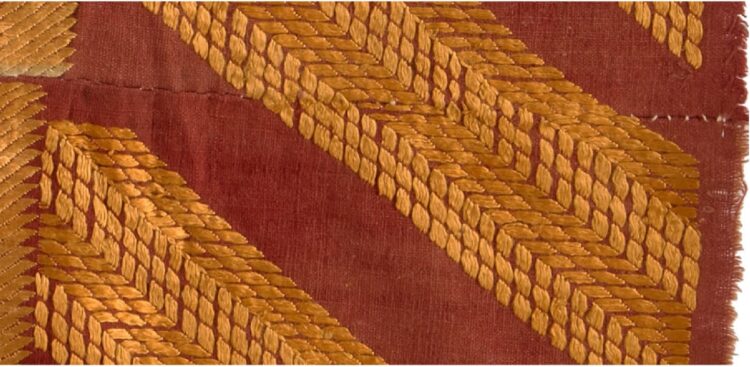
Figure 4. Detail of phulkari odhni showing detail of end border composition, pre-Partition Punjab, India. 20th century. 226.70 L x 130.18 W cm. Cotton and silk. George Washington University and The Textile Museum, 1985.57.47.
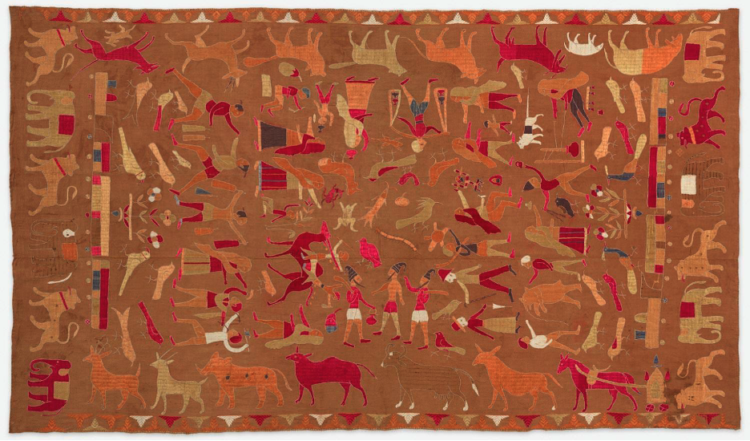
Figure 5. Sainchi phulkari, pre-Partition Punjab, India. 20th century. 233.7 × 137.2 cm. Cotton and silk. Philadelphia Museum of Art, The Jill and Sheldon Bonovitz Collection, 2017.9.18.
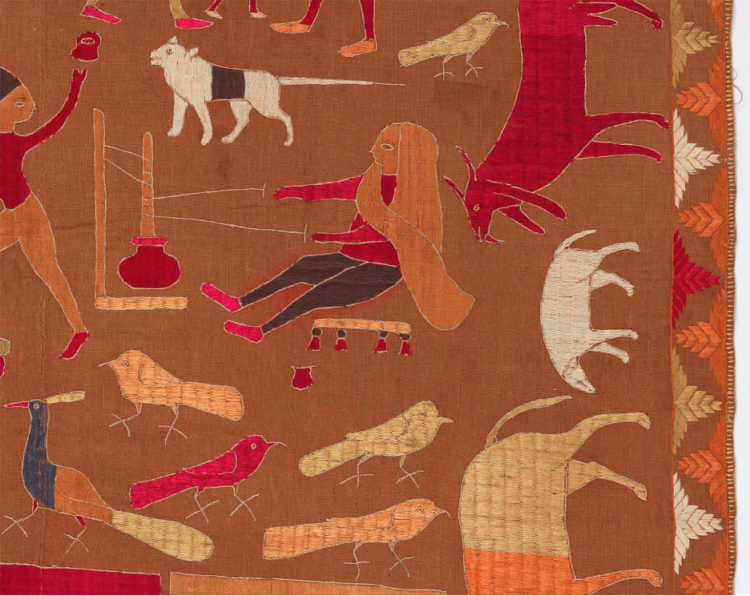
Figure 6. Detail of sainchi phulkari showing depiction of a female figure churning butter, pre-Partition Punjab, India. 20th century. 233.7 × 137.2 cm. Cotton and silk. Philadelphia Museum of Art, The Jill and Sheldon Bonovitz Collection, 2017.9.18.
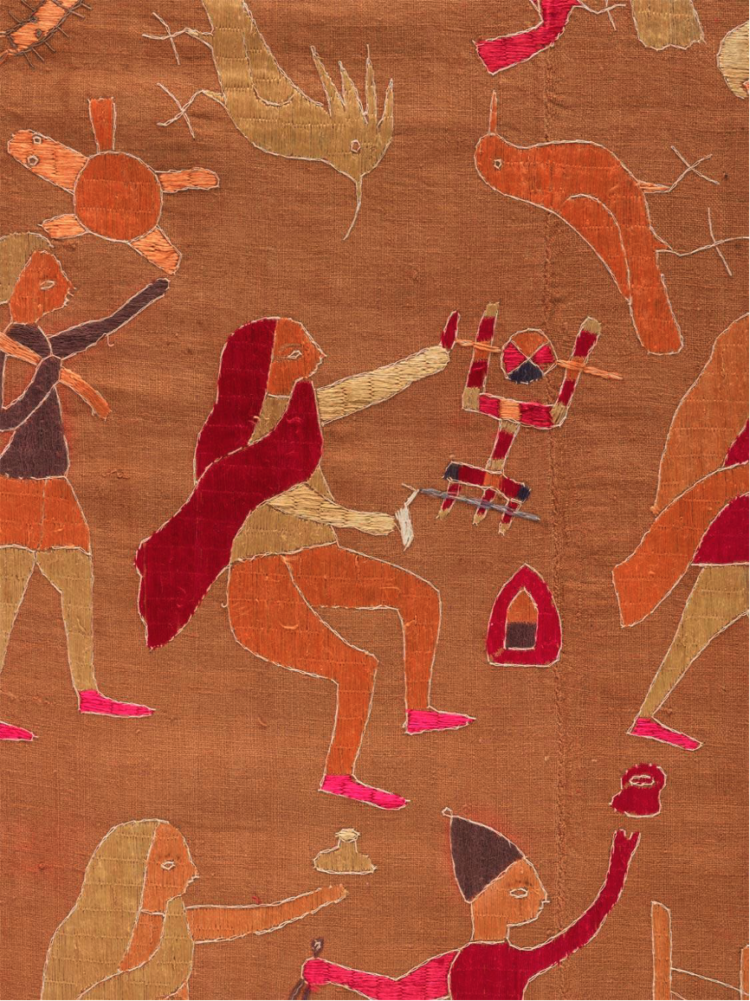
Figure 7. Detail of sainchi phulkari showing depiction of a female figure spinning thread, pre-Partition Punjab, India. 20th century. 233.7 × 137.2 cm. Cotton and silk. Philadelphia Museum of Art, The Jill and Sheldon Bonovitz Collection, 2017.9.18.
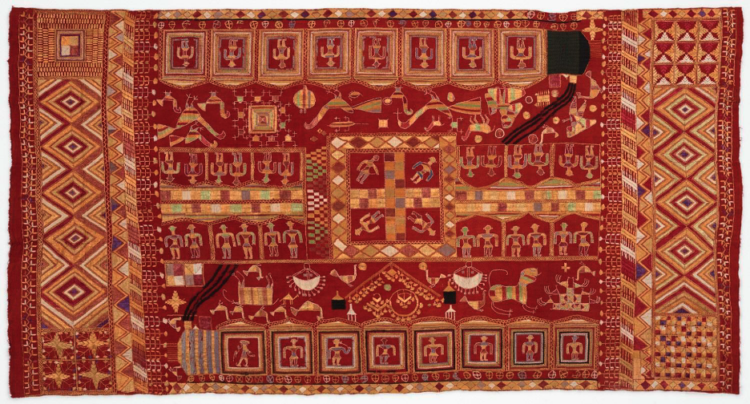
Figure 8. Sainchi phulkari, pre-Partition Punjab, India. 20th century. 227.3 × 123.2 cm. Cotton and silk. Philadelphia Museum of Art, The Jill and Sheldon Bonovitz Collection, 2017.9.14.
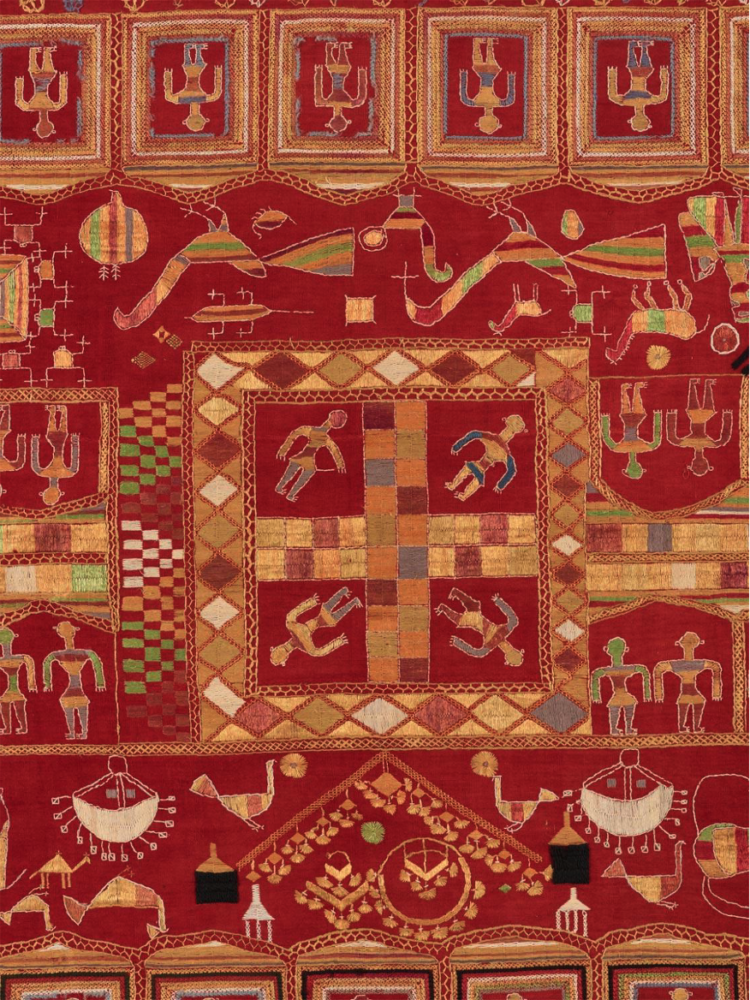
Figure 9. Detail of sainchi phulkari showing depiction of wedding jewelry, pre-Partition Punjab, India. 20th century. 227.3 × 123.2 cm. Cotton and silk. Philadelphia Museum of Art, The Jill and Sheldon Bonovitz Collection, 2017.9.14.
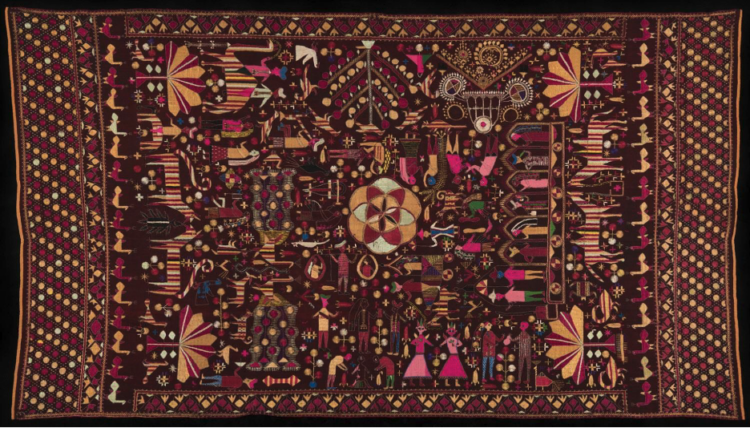
Figure 10. Sainchi phulkari, pre-Partition Punjab, India. 20th century. 245.1 × 141 cm. Cotton and silk. Philadelphia Museum of Art, Purchased with the Bloomfield Moore Fund and the Gertrude Schemm Binder Fund, 1994, 1994.173.1.
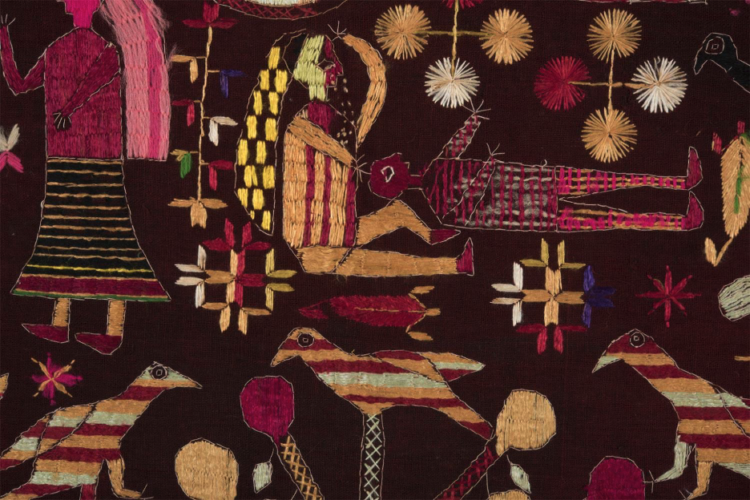
Figure 11. Detail of sainchi phulkari showing female figure weeping over deceased body, pre Partition Punjab, India. 20th century. 245.1 × 141 cm. Cotton and silk. Philadelphia Museum of Art, Purchased with the Bloomfield Moore Fund and the Gertrude Schemm Binder Fund, 1994, 1994.173.1.
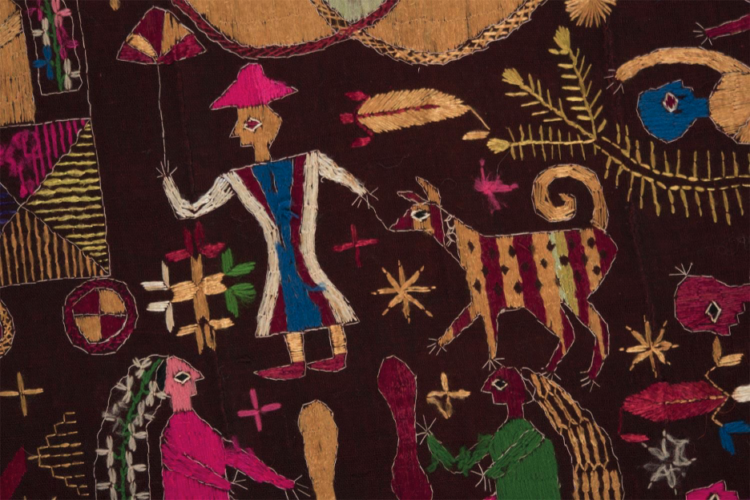
Figure 12. Detail of sainchi phulkari showing male figure wearing pith helmet and holding parasol, pre-Partition Punjab, India. 20th century. 245.1 × 141 cm. Cotton and silk. Philadelphia Museum of Art, Purchased with the Bloomfield Moore Fund and the Gertrude Schemm Binder Fund, 1994, 1994.173.1.
See Darielle Mason, ed. Phulkari: The Embroidered Textiles of Punjab from the Jill and Sheldon Bonovitz Collection (Philadelphia Museum of Art and Yale University Press, 2017).↩
See Cristin McKnight Sethi, “The Many Meanings of Phulkari Textiles,” in Mason, ed., Phulkari, 24–27.↩
For the “lives” of objects in and out of museums, see Richard Davis, Lives of Indian Images (Princeton University Press, 1997) and Tapati Guha-Thakurta, “Our Gods, Their Museums: The Contrary Careers of India’s Art Objects,” Art History Vol. 30, No. 4 (September 2007): 628–57.↩
Svetlana Alpers, “The Museum as a Way of Seeing,” Exhibiting Cultures, edited by Ivan Karp and Steven D. Lavine (Washington, DC: Smithsonian Institution Press, 1991): 25–32.↩

Durba Ghosh
Touch and the Figure of the Woman Revolutionary
From the opening pages of An Empire of Touch, we can tell we are in the hands of an innovative thinker and theorist. There are many threads (pun intended) in the book: I want to draw out several that speak to three elements of the book: first, the gendered subjectivity of revolutionaries; second, the ways that revolutionaries are materialized into commemorations of the nation and finally, how these material representations fit into the gendered politics of the nation in the postcolonial period.
The book is critically engaged in the “material turn” which is innovatively linked to the “revolutionary turn” in South Asian studies. The revolutionary turn in the scholarship on twentieth-century South Asia has shown that revolutionary and militant movements were a constitutive part of political culture and intellectual life, even as these radical and sometimes utopian projects failed to stem the tide of neocolonial development and neoliberal policies of the late twentieth century. The first chapter focuses on Pritilata Waddedar and expands the scholarship of Daniel Elam, Kama Maclean, Chris Moffatt, Jessica Namakkal, and Simona Sawhney, who have situated revolutionary imaginaries as a central feature of collective political and cultural worlds emerging from figures such as Bhagat Singh, Lala Har Dayal, Sri Aurobindo, and others. 1
One of the innovative elements of Empire of Touch is the centrality of the haptic and the gendering of female subjectivity. A dissertation by Sadia Shirazi, an art historian who is completing a dissertation at Cornell, shows that women artists in the postcolonial South Asian diaspora relied on abstract forms to represent touch and texture, distinguishing their work in predominantly patriarchal nationalist spaces. 2 Through the artistic work of Nasreen Mohammedi, Zarina, and Lala Rukh, Shirazi shows that the events of 1947—partition and the displacement of populations—produced feminist subjectivities that were shaped by exile, mobility, and diasporic imaginaries that destabilized national and territorial attachments. In their work, women artists challenged art worlds that largely excluded them or attempted (and failed) to discipline their vision. For these artists, partition led to exile and (unexpectedly) a level of diasporic mobility that did not tether them to the emergent nations of South Asia. These women artists refused the figurative, and in particular, images of the female figure which became so central to the forms of commemoration that were attached to someone like Pritilata Waddedar.
Empire of Touch thinks with and against the idea of national territory and its deterritorialization as India, Pakistan, and Bangladesh were partitioned and liberated through the twentieth century. The idea of “scattered hegemonies,” long ago articulated by Inderpal Grewal and Caren Kaplan, is critical to An Empire of Touch, which takes the space of East Bengal as its focus and thinks about how this part of Bengal generated foundational imaginaries for Bangladesh and India. 3 As Saha notes, “While Chittagong [in East Bengal, now Bangladesh] might have become part of a separate nation-state, the events of the 1930s can be coalesced within a narrative of incipient Indian independence, their telos redirected ex post facto (Saha 2019, 31).”
In Saha’s book, the haptic is linked to the making and circulation of textiles that takes us from their making in east Bengal to their remaking in postcolonial South Asia. Several passages are both moving and informative: who knew that taant filtered away bacteria?! (Saha 2019, 1-4 and 194-96) When Saha turns to the ways that textiles were used to rehabilitate women who were dispossessed of their lives and livelihoods in the 1971 war, she cleverly links the history of Bengali’s textiles to a history of technology in the sewing machine (Saha 2019, 218-20) and global commerce in the name of “fair trade” (Saha 2019, 228-30).
In a book that brings together touch and materiality, gender, and the vexed issue of representation, I want to direct our attention to the ways that one revolutionary subject, Pritilata Waddedar, appears in India and in Bangladesh. In the first chapter, which is suggestively titled, “Virgin Suicides,” Saha pairs an analysis of Pritilata’s life with the figure of Bhubaneswari, Gayatri Spivak’s great-niece whose story concludes the well-known essay, “Can the Subaltern Speak?”
As we learn, Pritilata was a member of an underground revolutionary group based in Chittagong that planned the Chittagong Armoury Raid, which took place on April 16, 1930. Chittagong, a city in east Bengal, was a hub for revolutionary activity (Saha 2019, 258, fn. 10). The raid led to a siege that lasted for four days; in the aftermath, the participants scattered into the hills, reportedly protected by local villagers. Pritilata was deputed in the aftermath of the raid to conduct a different attack, one at the Pahartali country club, where Europeans had gathered for an evening soiree. Like Kalpana Dutt, her classmate at Bethune College in Kolkata, Pritilata dressed as a man to evade police detection. When Pritilata was found after the attack, she was wearing male attire (Saha 2019, 51). Subsequently, colonial authorities enacted anti-terrorist legislation that prohibited anyone from wearing clothes that were not consistent with their religious or gender identity; the emergency legislation permitted the suspension of habeas corpus and called on suspected terrorists to be detained by colonial authorities to prevent further insurgent acts (Saha 2019, 63). As Saha astutely observes, “…the mandate against communal and gender cross-dressing sought to still the rebellious traffic of bodies in flight (Saha 2019, 64).”
In 2013, when the West Bengal State Archives promoted its collections during archive week, it mounted an exhibition of women revolutionaries who had been identified by the Intelligence Bureau. The flyer for the exhibition showed faces of the women in a series of head shots; the exhibition included two rooms of black and white photographs showing women in their homes and gardens, looking straight at the photographer. When I visited the exhibition, I noticed that the images in the exhibition showed the full bodies of the women wearing simple cotton saris, mostly white or light-colored, and plainly made without embroidery or prints. Even though most revolutionary women refused to conform to gendered expectations by learning how to ride bicycles, swimming, martial arts, and shooting a gun, when they were shown publicly or had their bodies and faces recorded, they were clad in the respectable cotton sari made by handloom. As we know of the nationalist movement, even while women were asked to give up luxuries such as gold jewelry to support the anticolonial cause, they were encouraged to consume products that showcased Indian-made goods, such as handloom saris. 4
The photographs were not police portraits, which was a common way of keeping track of revolutionary terrorists; instead, they look like family portraits of bourgeois women. Coupled with the many narratives that women revolutionaries were “good girls” who had studied hard, been good students, supported their families, the exhibit at the state archives consolidated a vision of middle-class womanhood in which women became revolutionaries under the extreme circumstances of colonial occupation. 5 As Saha writes of the photograph of Pritilata on display in the West Bengal State Archives, “It is an image that coheres with the statement she offered authorities, of recognizable Bengali femininity and normative embodiment (Saha 2019, 67).” Sarmishta Dutta Gupta shows that revolutionary groups in Bengal made particularly gendered demands of women who were active in the movement. 6
In 2012, on the eightieth anniversary of Pritilata’s death, a bronze bust of Pritilata was installed in Chittagong, Bangladesh outside the site of the Pahartali Institute (Saha 2019, 69). The placement of this bust makes some historical sense as a memorial: it was reportedly near where her body was found. Her face is modeled after the photograph that has circulated widely and appears on page 68 of Saha’s book.
On the maidan in Kolkata, West Bengal, there is a different statue, distinct in scale and in perspective: a full body sized statue of Pritilata is shown standing. Mounted on a tall pedestal, she appears to be waving at those driving by as she towers over Indira Gandhi Sarani which borders the maidan. Her left hand is in a fist. In both of these representations, Chittagong and Kolkata, Pritilata is shown wearing a sari, draped over her left shoulder. In the Kolkata version, the end of the sari is wound around her waist, suggesting a less formal stance. A formal way of wearing the sari would allow the pallu to hang over the left shoulder; an informal way would involve winding the end around the waist so that it did not drag on the floor or get in the way of her body’s movement. Her positioning is very active, she appears to be in motion. Unlike the bust mounted in Chittagong, the sculptor would have had to imagine her standing since there are few such images of preserved of her.
We might imagine that a statue of Pritilata was installed in the capital city of West Bengal because she attended college there. In 2012, she was granted her degree from Bethune College, a degree she had been denied because of her activism. The statue in West Bengal credits the young woman revolutionary as a freedom fighter of India; the statue in Chittagong positions her as an inspiration for the liberation of Bangladesh, the nation that emerged in 1971 after months of underground warfare, much as Pritilata had engaged in when she fought the British occupation.
If we think of these commemorations as marking national spaces, we might imagine that these statues territorialize the space of the nation as they simultaneously materialize nationalist imaginings of womanhood. 7 Much as the Asutosh Gowariker film, Khelein Hum Jee Jaan Sey suggest, the statues make possible “The incorporation of Chittagong back into the body of India reimagines the relationship between anticolonial resistance and postcolonial nationalism, refusing to acknowledge the multiple ruptures by which those two sites have been geographically separated from one another (Saha 2019, 30).”
Situated nearly four hundred miles apart, the two sites draw from a shared moment in South Asia’s history of revolutionary nationalism even though India did not have a revolution, and Bangladesh’s revolutionary principles were central to its founding. In these statues, the history of a revolutionary freedom-fighting heroine has been made respectable for public consumption: even though Pritilata was found wearing men’s clothes she is shown wearing a sari. This type of commemoration suggests that she can be only be represented as a historical figure if she is shown conforming to gendered expectations.
In bringing Saha’s thought-provoking book into conversation with a reading of these statues of Pritilata, I end with some frustration with the persistence of gendered norms, even in putatively revolutionary projects. These statues represent a revolutionary past in which women gendered non-normatively (dressing as men) could never be part of a revolutionary imaginary. The persistence of patriarchal hegemonies, materialized through these statues and scattered across two national sites suggests that the subjectivity of women is largely still framed by issues of their respectability.
As history is materialized for public view in the form of statues, the body of the revolutionary who planned a violent attack on a European club is pressed into the service of nationalist aims. Inspired by Sadia Shirazi’s arguments on “fugitive abstraction” that frames her analysis of women artists in the latter half of the twentieth century, I suggest that a more radical commemoration of Pritilata might have been a sculpture that moved away from representing her body or face. A departure from figurative norms would have allowed a commemoration to Pritilata’s life and career to be open to a truly revolutionary reading. As Saha writes in one of the most pungent and poignant moments of her thoughtful book, “Who is a revolutionary? And what is a revolution if it brings no liberation? (Saha 2019, 31).”
Figure 1
http://wbsadte.gov.in/exhibitions-2013.php
Figure 2
Chittagong, Bangladesh: adjacent to the club where she died. Credit: https://commons.wikimedia.org/wiki/File:Bust_of_Pritilata_Waddedar.JPG
Figure 3
Kolkata, India: on the Maidan, near Indira Gandhi Road
https://www.shutterstock.com/image-photo/statue-pritilata-waddedar-calcutta-india-photographed-606299873
Daniel Elam, World Literature for the Wretched of the Earth (New York: Fordham University Press, 2020): Kama Maclean, A Revolutionary History of Interwar India: Violence, Image, Voice and Text (Oxford: Hurst Publications, 2015); Chris Moffat, India’s Revolutionary Inheritance: politics and the promise of Bhagat Singh (Cambridge: Cambridge University Press, 2019); Jessica Namakkal, Unsettling Utopia: the making and unmaking of French India (New York: Columbia University Press, 2021); Simona Sawhney, “Death in three scenes of recitation,” Postcolonial Studies 16.2 (2013): 202–15, special issue on “Reading Revolutionaries: texts, acts, and afterlives of political action in late colonial South Asia,” edited by Maclean and Elam.↩
Sadia Shirazi, Fugitive Abstraction: Zarina, Nasreen Mohamedi, and Lala Rukh (PhD dissertation, Cornell University, 2021. In the interests of full disclosure, I am a member of her PhD committee.↩
Inderpal Grewal and Caren Kaplan, eds., Scattered Hegemonies: postmodernity and transnational feminist practices (Minneapolis: University of Minnesota Press, 1994).↩
Lisa Trivedi, Clothing Gandhi’s Nation: Homespun and Modern India (Bloomington: Indiana University Press, 2007).↩
Durba Ghosh, “Revolutionary Women and Nationalist Heroes in Bengal, 1930 to the 1980s,” Gender and History 25.2 (August 2013): 355–75.↩
Sarmishta Dutta Gupta, “Death and Desire in Times of Revolution,” Economic and Political Weekly volume 48, issue 37 (14 September 2013).↩
Manu Goswami, Producing India: from colonial economy to national space (Chicago: University of Chicago Press, 2004); Sumathi Ramaswamy, The Goddess and the Nation: mapping Mother India (Durham: Duke University Press, 2010).↩
7.20.23 | Poulomi Saha
Saha Response to Ghosh
For all my interest in touch and the material, An Empire of Touch is a book tied up in ghosts and spectrality. There are many things by which it and its writing were haunted: Dhakai muslin no longer manufactured, a fantastical wholeness of nation so critical to a postcolonial project, archival records of violence and attempts of reparation. But there’s been no more persistent ghost than that of Pritilata Waddedar, who is, in so many ways, the starting point of this book. Like many occult encounters, it is difficult to describe the force of being enthralled by this historical figure who first appeared in the archive rather elliptically—with so many varied spellings of her name that she was nearly impossible to trace. But for years, I couldn’t shake twenty-year-old Pritilata, who in police reports is described as ugly and in nationalist histories as resplendently heroic. For her short life and the seeming failure of the revolutionary project to which she committed it should have made her a blip in my mind, like she was in the archive. No such luck. She was, like I said, persistent.
The first time I was able to give this ghost really a form was at the 2013 photographic exhibit at the West Bengal State Archives that Durba Ghosh describes in her essay. It only ran a week so we must have visited it around the same time, stood in that spare room with laminated photos mounted to the walls. Durba, it’s clear from her description, studied those images as closely as I had—maybe also looking to give form to ghosts. I had seen photos of Pritilata before, mostly versions of the same image variously cropped, that show her unsmiling face looking directly into the camera. At the West Bengal State Archives exhibit though, there was a second photograph of her, which Durba aptly describes as “look[ing] like family portraits of bourgeois women.” In this full-length image, she is seated in a chair at an angle; her head is turned to look at the camera positioned slightly lower than eye-level. It’s both mundane as an image, one of many such portraits of bourgeois women, and startling. That image, that both Durba and I once stood in front of, conjures to life more vividly than I had seen before the at once mundane and exceptional Pritilata Waddedar.
For some time, then, it seemed that image could do necromantic work—enliven the dead. But it remained two-dimensional and, by virtue of the mandated distance between viewer and museum object that Christin Sethi and I talk about, distant from my longing to touch. Touch literally, to handle the photograph of her captured image, and touch affectively, to bring her closer to me, to incorporate her ghostly form into me. Maybe it is this desire for a kind of materialized proximity to the form of the dead that drives the commemorative impulse to render historical figures into sculpture. I am utterly convinced by Durba’s radical suggestion that a more apt commemoration of Pritilata Waddedar should leave the limited form of representation tied to the body and the face. Sadia Shirazi’s gambit of a “fugitive abstraction” already conjures Pritilata anew, as a fugitive, as absconding. While in the colonial record Pritilata is accused of absconding, a term that describes the attempts of revolutionaries to flee police, she evades more than just being arrested. Pritilata absconds from our own attempts to fix her into narrative, to understand her by the limited frames of heroism and terrorism. What is so haunting about Pritilata Waddedar is precisely the impossibility of capturing her neatly as a historical figure and also a figure of my own projected desire. When I say she was a persistent ghost, I mean that she continues to refuse my attempts to know, and in knowing, come to some appreciable form for her so she can be settled as a historical object, consigned to the closed door of the past.
What then might an abstract commemoration of Pritilata, my ghost and the historical figure both, look like? What would become of her if I gave up my desire to give her form? To render her, as Cristin Sethi reminds us, capturable within the imagination of the museum and the archive? I can’t but think here of the other proleptically ghostly figure of this project, of Gurudasi Mondal who, seventy years after Pritilata’s death, hoped that the public claims of her heroism would mean that when she died, there would be a memorial for her. Though she never says what kind of memorial it ought to be, I wonder if something of its form did not appear to her as she sat in the village mandir, supplicant before the murtis of Durga and Kali. Murti, from the Sanskrit for solid form or embodiment, is the word given to the three-dimensional image of the deity. It is not, quite decisively in both scripture and lay understanding, the deity themselves but also not simply a representation. Instead, a murti is the manifestation of the divine in a form appreciable to us, imbued with its force while made of common substance, often clay. Is the desire to be remembered by the social—commemorated—a desire to be manifested in another form? That is, less a fixed and lifeless artifact of that which no longer exists and more an ongoing form of being. For Gurudasi Mondol, it seems clear that she wishes for a future form of herself to remain, local to a place that is her home and intimate to people who have known or heard of her. I can surmise this because she says, as closely as she can render into language, what she hopes will become of her memory, how it will come to endure in material form.
We do not have such an artifact of speech from Pritilata Waddedar. What we have are the archival traces of her writing, political manifestos adhered to her body, and accounts of those to whom she was close. If one question of An Empire of Touch was “who is a revolutionary,” Durba’s essay demands a new one: “what is a revolutionary commemoration?” How do we give social, material form to the revolutionary subject? Especially as we stave off the desire to fix that subject into the normative frames of history, of gendered being, of nationalist imagination. So as an invitation to collaboratively re-envision the project of revolutionary memory and keeping close at hand Neelofer Qadir’s question about the possibility of repair, I’ll offer my first gambit at a memorial for Pritilata Waddedar. If we are pulled between the gendered disciplining of the photographic and sculptural forms of her, clothed in the iconography of traditional Bengali femininity, and the repeated accounts of her body found clothed as a “Punjabi” man, for which we have no visual proof, then maybe a memorial of her is that disappeared clothing. I do not know that it will appease her ghost, but I wonder if perhaps a revolutionary memorial for Pritilata Waddedar might not be a cotton kurta and pyjama, left out as her body was, availed to elements, to the decay and organic transformations that marble and stone refuse. Perhaps the worthy memorial to her is the one which refuses our impulse to fix her in place, to render her familiar to us, to preserve her as we wish she had been.